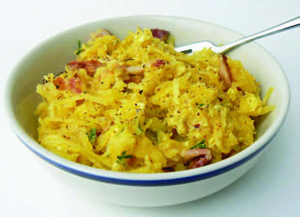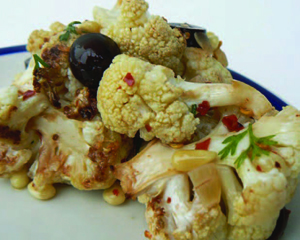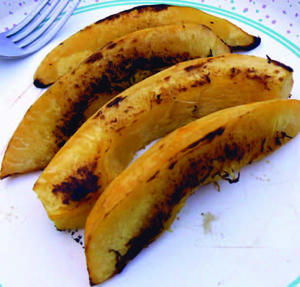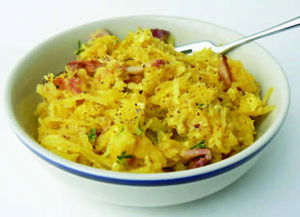Recipes: Issue 33

Cauliflower with Black Olive Vinaigrette
Prep time: 12 minutes
Cooking time: 30 minutes
• 1 medium head of cauliflower (6 cups)
• 4 Tbsp olive oil (divided)
• 1/4 cup sliced kalamata olives
• 2 Tbsp minced parsley
• 1 Tbsp pine nuts
• 1 Tbsp red wine vinegar
• 2 cloves garlic, minced
• 1/4 tsp red pepper flakes
• black pepper to taste
Cut the cauliflower into medium pieces, then place into a roasting pan. Add 1 Tbsp of olive oil, toss well to coat the cauliflower. Place into an oven preheated to 350 degrees, roast for around 30 minutes, or until soft. Be sure to turn the pieces several times as they roast.
Meanwhile, prepare the vinaigrette in a medium bowl. Add all of the remaining ingredients to the bowl, mix. Once the cauliflower is done, allow it to cool. Add to the bowl, toss well. Enjoy!
Zone info: 2 servings at 1.5 carb blocks, 22 fat blocks.
Note: those eating lighter can reduce the olive oil to meet their fat block needs.

Applesauce
Homemade applesauce can be a great way to use all those apples that you might have growing on a tree in your yard. Even if you don’t have a tree, apples are cheap and plentiful this time of year. We’ve been making applesauce regularly as the summer winds down, so I’ll share a basic recipe that we use, and some favorite variations.
Start by cutting your apples in half, and then removing the core and stems. Slice the apples into small pieces. We usually like to leave the skins on for some additional nutrients and fiber, but you can also peel the apples if you prefer a more traditional applesauce or plan to use it as a sugar substitute.
Place about 1/4 inch of water in the bottom of a large pot, then add the apple pieces. Add any spices or other fruits (see recipe variations below), then cover and boil over medium heat for around 30 minutes. The apples should be soft.
Mash well with a potato masher, then it’s done. Serve warm, or transfer the applesauce to jars for storage in the refrigerator.
Some variations:
• Add 6 cinnamon sticks and 2 Tbsp of cinnamon powder before boiling for cinnamon applesauce. Remove the sticks before storage.
• Pick fresh blackberries, then add to the apples in 1:4 ratio. Blackberry applesauce!
• Peel and mince 2-3 tablespoons of fresh ginger for ginger applesauce.
Zone info: 1 cup applesauce = 3 carb blocks
Cabbage and Bacon
Here is a quick way to prepare some veggies that you can have on hand for several meals. This is surprisingly tasty - several friends of mine who rarely ever touch the green stuff loved it. See if you can win over some veggie-phobic friends....
Prep time: 5 minutes
Cooking time: 1 hour
• 1 head green cabbage (~8 cups)
• 2 slices bacon (nitrate free)
Chop the bacon into small pieces, then fry in a large skillet over medium heat. While the bacon browns some, chop the cabbage into medium chunks. No need to shred it very finely.
Once the bacon has browned some, add all of the cabbage. Cover the skillet and cook over medium low for 1 hour, tossing the cabbage occasionally. Serve some warm, then save the rest for later. This ends up being pretty good served cold!
Zone info: 4 servings at 2 carb blocks, 2 fat blocks
Squash Fries
Do you occasionally miss French fries? If so, here is a simple way to come pretty close, and still stay healthy. I got this idea from Art Devany’s blog, and recently tried it out on my annual trip to the mountains.
Time: 10 minutes
• Acorn squash
• Olive oil
Cut an acorn squash in half lengthwise, then dig out the seeds. Cut it into wedges about 1 inch thick. Peel the wedges with a potato peeler. (I did this part at home, then I put the wedges into a ziplock bag to take on my trip.) You can grill these, or roast them in a pan. Brush the squash with olive oil, then place on the grill or in a pan. Turn frequently, until the squash is soft. Serve hot.
You can also spice these up any way that you like: chili powder or cajun spices would be a good place to start.
Zone info: 1 cup acorn squash fries will be 1.4 carb blocks, ~ 2 fat blocks.

Spaghetti Squash Carbonara
This dish substitutes spaghetti squash for the traditional pasta. Presto! Lower glycemic load, better nutrient profile, tastes just as good or better than the original, and none of the negative impact of grains. Though this makes a great breakfast, it is traditionally an evening meal.
This can be prepared quickly, especially if you have cooked the spaghetti squash ahead of time.
Time: 10 minutes (w/precooked squash)
• 4 cups cooked spaghetti squash
• 2 slices bacon (nitrate free)
• 2 eggs
• 3 Tbsp minced parsley
• 1 Tbsp olive oil
• 2 cloves minced garlic
• 1/2 tsp red pepper flakes
• black pepper
To cook the spaghetti squash: Cut it in half lengthwise, remove the seeds and ropy fibers, then place the halves face down in a baking dish or roasting pan. Add 1/4 cup of water, then bake at 350 degrees for around 40 minutes, or until soft. I then place the cooled squash in the refrigerator for use later.
To make the Carbonara: Heat the olive oil in a skillet, then cut the bacon strips into small pieces. Fry the bacon for several minutes until it is beginning to brown, then add the minced garlic. After a minute, add the precooked spaghetti squash. You will simply scoop out the squash meat from the shell; it will come out into nice, pasta-like strands. I find that one half of a squash
will measure out to be about 4 cups. Toss the squash and bacon frequently, until warm.
Meanwhile, crack the eggs into a small bowl. Add the parsley and spices. Whip the mixture with a fork until it is well blended, then add to the skillet. Toss until the eggs set. Serve warm, and top with additional black pepper to taste.
Zone info: 2 servings at 1.25 carb blocks, 1.75 protein blocks, 12 fat blocks

Prep time: 12 minutes
Cooking time: 30 minutes
• 1 medium head of cauliflower (6 cups)
• 4 Tbsp olive oil (divided)
• 1/4 cup sliced kalamata olives
• 2 Tbsp minced parsley
• 1 Tbsp pine nuts
• 1 Tbsp red wine vinegar
• 2 cloves garlic, minced
• 1/4 tsp red pepper flakes
• black pepper to taste
Cut the cauliflower into medium pieces, then place into a roasting pan. Add 1 Tbsp of olive oil, toss well to coat the cauliflower. Place into an oven preheated to 350 degrees, roast for around 30 minutes, or until soft. Be sure to turn the pieces several times as they roast.
Meanwhile, prepare the vinaigrette in a medium bowl. Add all of the remaining ingredients to the bowl, mix. Once the cauliflower is done, allow it to cool. Add to the bowl, toss well. Enjoy!
Zone info: 2 servings at 1.5 carb blocks, 22 fat blocks.
Note: those eating lighter can reduce the olive oil to meet their fat block needs.

Applesauce
Homemade applesauce can be a great way to use all those apples that you might have growing on a tree in your yard. Even if you don’t have a tree, apples are cheap and plentiful this time of year. We’ve been making applesauce regularly as the summer winds down, so I’ll share a basic recipe that we use, and some favorite variations.
Start by cutting your apples in half, and then removing the core and stems. Slice the apples into small pieces. We usually like to leave the skins on for some additional nutrients and fiber, but you can also peel the apples if you prefer a more traditional applesauce or plan to use it as a sugar substitute.
Place about 1/4 inch of water in the bottom of a large pot, then add the apple pieces. Add any spices or other fruits (see recipe variations below), then cover and boil over medium heat for around 30 minutes. The apples should be soft.
Mash well with a potato masher, then it’s done. Serve warm, or transfer the applesauce to jars for storage in the refrigerator.
Some variations:
• Add 6 cinnamon sticks and 2 Tbsp of cinnamon powder before boiling for cinnamon applesauce. Remove the sticks before storage.
• Pick fresh blackberries, then add to the apples in 1:4 ratio. Blackberry applesauce!
• Peel and mince 2-3 tablespoons of fresh ginger for ginger applesauce.
Zone info: 1 cup applesauce = 3 carb blocks
Cabbage and Bacon
Here is a quick way to prepare some veggies that you can have on hand for several meals. This is surprisingly tasty - several friends of mine who rarely ever touch the green stuff loved it. See if you can win over some veggie-phobic friends....
Prep time: 5 minutes
Cooking time: 1 hour
• 1 head green cabbage (~8 cups)
• 2 slices bacon (nitrate free)
Chop the bacon into small pieces, then fry in a large skillet over medium heat. While the bacon browns some, chop the cabbage into medium chunks. No need to shred it very finely.
Once the bacon has browned some, add all of the cabbage. Cover the skillet and cook over medium low for 1 hour, tossing the cabbage occasionally. Serve some warm, then save the rest for later. This ends up being pretty good served cold!
Zone info: 4 servings at 2 carb blocks, 2 fat blocks
Squash Fries
Do you occasionally miss French fries? If so, here is a simple way to come pretty close, and still stay healthy. I got this idea from Art Devany’s blog, and recently tried it out on my annual trip to the mountains.
Time: 10 minutes
• Acorn squash
• Olive oil
Cut an acorn squash in half lengthwise, then dig out the seeds. Cut it into wedges about 1 inch thick. Peel the wedges with a potato peeler. (I did this part at home, then I put the wedges into a ziplock bag to take on my trip.) You can grill these, or roast them in a pan. Brush the squash with olive oil, then place on the grill or in a pan. Turn frequently, until the squash is soft. Serve hot.
You can also spice these up any way that you like: chili powder or cajun spices would be a good place to start.
Zone info: 1 cup acorn squash fries will be 1.4 carb blocks, ~ 2 fat blocks.

Spaghetti Squash Carbonara
This dish substitutes spaghetti squash for the traditional pasta. Presto! Lower glycemic load, better nutrient profile, tastes just as good or better than the original, and none of the negative impact of grains. Though this makes a great breakfast, it is traditionally an evening meal.
This can be prepared quickly, especially if you have cooked the spaghetti squash ahead of time.
Time: 10 minutes (w/precooked squash)
• 4 cups cooked spaghetti squash
• 2 slices bacon (nitrate free)
• 2 eggs
• 3 Tbsp minced parsley
• 1 Tbsp olive oil
• 2 cloves minced garlic
• 1/2 tsp red pepper flakes
• black pepper
To cook the spaghetti squash: Cut it in half lengthwise, remove the seeds and ropy fibers, then place the halves face down in a baking dish or roasting pan. Add 1/4 cup of water, then bake at 350 degrees for around 40 minutes, or until soft. I then place the cooled squash in the refrigerator for use later.
To make the Carbonara: Heat the olive oil in a skillet, then cut the bacon strips into small pieces. Fry the bacon for several minutes until it is beginning to brown, then add the minced garlic. After a minute, add the precooked spaghetti squash. You will simply scoop out the squash meat from the shell; it will come out into nice, pasta-like strands. I find that one half of a squash
will measure out to be about 4 cups. Toss the squash and bacon frequently, until warm.
Meanwhile, crack the eggs into a small bowl. Add the parsley and spices. Whip the mixture with a fork until it is well blended, then add to the skillet. Toss until the eggs set. Serve warm, and top with additional black pepper to taste.
Zone info: 2 servings at 1.25 carb blocks, 1.75 protein blocks, 12 fat blocks

|
Scott Hagnas is owner of CrossFit Portland. He is certified as a CrossFit level 2 trainer and Circular Strength Training (clubbell) instructor. He has been riding BMX flatland for 26 years and counting and has filmed/produced/edited several series of BMX videos, plus several training videos. He formerly competed in bicycle trials, placing second in amateur in the World Championships in 1990. Cooking is one of his favorite pastimes. |
Search Articles
Article Categories
Sort by Author
Sort by Issue & Date
Article Categories
Sort by Author
Sort by Issue & Date

